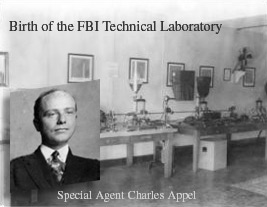|
11/24/03

We
have to admit straight out that November 24,1932, is a “declared”
anniversary for what was really the evolution of the FBI Lab.
From the 1920s on, Director Hoover was actively interested
in scientific analysis, and by 1930 he had ordered the use
of outside experts on a case-by-case basis in identification
and evidence matters. Then, over a two-year period, the first
true FBI “technical” laboratory functions began
to take shape. When all these functions moved into Room 802
of the Old Southern Railway Building in Washington, DC, it
seemed appropriate to recognize that a true lab had been born.
It
was Special Agent Charles Appel who served as midwife.
He had served as an aviator in World War I before joining
the FBI in 1924—and right from the start he focused
on meticulous investigations based on scientific detection.
For about a year, he was the FBI’s one-man lab. His
analysis of handwriting on the Lindbergh kidnapping ransom
notes ultimately convicted Bruno Richard Hauptman. His handwriting
and typewriter font analysis solved a poisoning case in 1933.
Appel
was an extraordinary man with extraordinary vision, fully
backed by Director Hoover with the necessary resources. When
he proposed in July 1932 “a separate division for the
handling of so-called crime prevention work” under which
“the criminological research laboratory could be placed,”
he got an immediate endorsement. By September, Room 802 was
fully equipped. By November 24, it was in business.
How
sophisticated was the new lab? Pretty sophisticated
by 1932 standards:
- A
brand new ultra-violet light machine.
- A
microscope, on loan from Bausch and Lomb til the requisition
for its purchase could be finalized.
- A
machine to examine the interior of gun barrels was on order.
- Moulage
kits (for taking impressions).
- Wiretapping
kits.
- Photographic
supplies.
- Chemical
sets.
What
hath 71 years wrought? A lot, as you can imagine.
Our laboratory just moved last year into a state-of-the-art
building, and it is involved in every kind of forensic analysis
(cryptanalysis, firearms and toolmarks, and latent fingerprints)
and scientific analysis (chemistry, chemical biological sciences,
DNA analysis, explosives, and trace evidence), with a strong
research and development arm in both.
To find
out more on all these areas, please visit:
|


